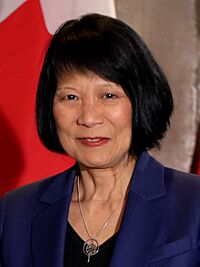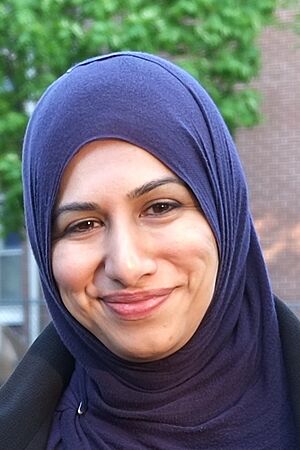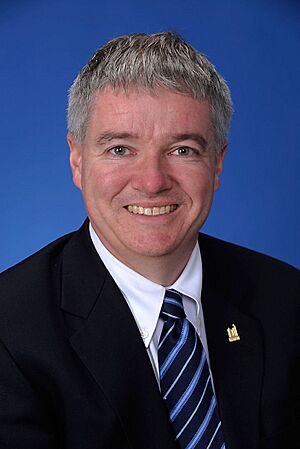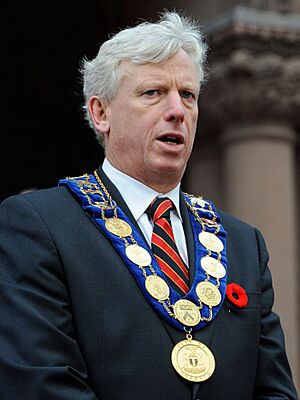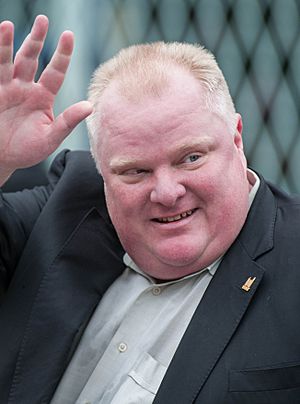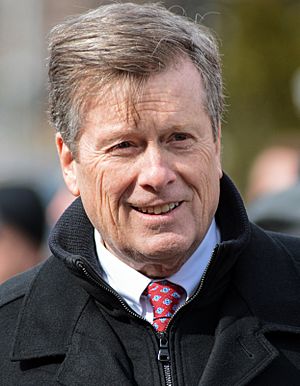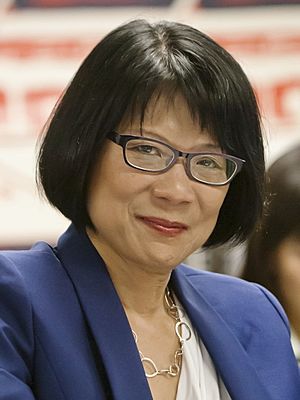Mayor of Toronto facts for kids
Quick facts for kids Mayor of Toronto |
|
|---|---|
Municipal logo
|
|
| City of Toronto Office of the Mayor |
|
| Style |
|
| Member of | Toronto City Council |
| Seat | Toronto City Hall |
| Appointer | Direct election |
| Term length | 4 years;
renewable
|
| Constituting instrument | City of Toronto Act |
| Inaugural holder | William Lyon Mackenzie (historic) Mel Lastman (post-amalgamation) |
| Formation | March 6, 1834 (historic) December 1, 1998 (current) |
| Deputy | Deputy Mayor |
| Salary | CA$202,948.20 |
The mayor of Toronto is the main leader of Toronto City Council. They are also the chief executive officer for the city government. People vote for the mayor every four years on the fourth Monday of October. There is no limit to how many terms a mayor can serve. While in office, mayors are called His/Her Worship.
Olivia Chow is the 66th and current mayor of Toronto. She started her term on July 12, 2023. She won the by-election held that year.
Contents
What the Mayor Does
The mayor of Toronto's job and powers come from a law called the City of Toronto Act. This law was first made in 1997 and updated in 2006. It says the mayor leads the city council and is the main boss of the City of Toronto. In 2022, new laws from the province, like the Strong Mayors, Building More Homes Act, gave the mayor even more power.
Leading City Council
As the head of the council, the mayor makes sure meetings run smoothly. This job is often done by the speaker of Toronto City Council. However, the mayor can take over as chair during any council meeting. The mayor can also add new topics directly to the city council's agenda. They do not need to go through a committee first.
The mayor is also a member of all council committees. They lead important committees like the Executive Committee. The mayor chooses who will lead other city committees. They also pick the deputy mayor. If the mayor agrees, another council member can take their place on a committee. The mayor is also in charge of declaring emergencies in the city.
Mayor's Expanded Powers
Before 2022, Toronto had a "weak-mayor" system. This meant the city council held most of the power. The mayor had to work with others to get things done. The Strong Mayors Act changed this. It gave the mayor more power, making it a "strong-mayor" system.
The Strong Mayors Act gives the mayor more control over how City Council's committees work. The mayor can create or close committees. They also appoint the people who lead these committees. The mayor can also ask city staff to write reports or develop new policies. This helps the city council make decisions.
The mayor also decides how the city government is organized. This includes creating or closing city departments. They can also hire or fire top staff, like the city manager. The city manager is the main administrative officer.
Another key job for the mayor is creating the city's yearly budget. Before, the city council set the budget. Now, the mayor drafts the budget first. The mayor then presents it to the council. The council can approve it or suggest changes.
Working with Provincial Priorities
Some of the mayor's powers are used to help with "provincial priorities." These are goals set by the province of Ontario. The mayor can add items to council's agenda to support these priorities. This is true even if it goes against council's usual rules.
The mayor also has a veto power. This means they can stop a city council decision if it does not match a provincial priority. However, the council can overrule the mayor's veto. They need a two-thirds majority vote to do this. A newer law, the Better Municipal Governance Act, gives the mayor even more power. They can pass a new law to help a provincial priority with only one-third support from council. The provincial government sets these priorities.
Deputy Mayor
The mayor can choose city councillors to be deputy mayors. These deputy mayors can help the mayor with their duties. Some have specific legal powers, while others have honorary roles.
| Portrait | Deputy mayor | Term began | Area represented/policy role | Constituency as councillor | |
|---|---|---|---|---|---|
| Ausma Malik | August 10, 2023 | Statutory deputy mayor; Toronto and East York | Ward 10 Spadina—Fort York | ||
| Paul Ainslie | May 21, 2025 | Non-statutory; Scarborough | Ward 24 Scarborough—Guildwood | ||
| Michael Colle | August 10, 2023 | Non-statutory; North York | Ward 8 Eglinton—Lawrence | ||
| Amber Morley | August 10, 2023 | Non-statutory; Etobicoke | Ward 3 Etobicoke—Lakeshore |
Statutory Deputy Mayor
The first deputy mayor has special legal duties. This person is chosen by the mayor from the city council. They help the mayor by being the vice-chair of the executive committee. They also act as mayor if the mayor is away, sick, or if the mayor's office is empty. This deputy mayor has almost all the mayor's powers.
When the Mayor's Office is Empty
If the Mayor of Toronto's office becomes empty, the deputy mayor takes on some mayoral powers. This ensures that city business can continue. They act as the city's chief executive and represent the city. They also manage the mayor's office.
However, the deputy mayor does not become the "acting" or "interim" mayor. They also do not get the "strong-mayor" powers. These special powers are given by the province to the head of council. The role of head of council remains empty until a new mayor is chosen.
Non-Statutory Deputy Mayors
In 2014, the city council created three more deputy mayor positions. These are "non-statutory" roles. This means they do not have special legal powers. The mayor appoints these councillors. They advise the mayor on local issues. They also represent the mayor at events. Each of these deputy mayors represents a different part of the city. They also focus on specific policy areas. The deputy mayors and the mayor meet monthly to discuss city matters.
History of Toronto's Mayors
From 1834 to 1857, and again from 1867 to 1873, Toronto mayors were not directly elected. Instead, after yearly elections for council members, the council would choose one of their own to be mayor. In other years, people voted directly for the mayor. Sometimes, if a mayor left office early, the council would appoint someone to finish the term. Before 1834, the city was led by the chairman of the Home District Council.
Until 1955, the mayor and council served one-year terms. This changed to two or three years, and then to a four-year term starting in 2006.
The City of Toronto has grown a lot over time. It joined with nearby communities many times between 1883 and 1967. The biggest change happened in 1998. Six municipalities around Toronto, like East York and Scarborough, joined together. This created one large "megacity" of Toronto. The new mayor of this large city replaced all the mayors of the smaller areas. It also ended the job of the Metro chairman, who used to be the top political leader. Since 1998, Toronto's mayor is elected by the largest number of voters in Canada for a single position.
Many of Toronto's early mayors were lawyers. Most mayors have been white, English-speaking men who owned property. Toronto has had two women mayors and three Jewish mayors.
Art Eggleton served the longest as mayor, from 1980 to 1991. David Breakenridge Read was mayor for the shortest time, only fifty days in 1858.
No Toronto mayor has ever been officially removed from office.
Mayors Since the "Megacity" was Formed
The current City of Toronto was created in 1998. This happened when Metro Toronto and its smaller cities joined together. Below is a list of the mayors of this new, larger Toronto.
| No. | Photo | Mayor | Terms of office | Took office | Left office | Statutory Deputy Mayor |
|---|---|---|---|---|---|---|
| 62 | Mel Lastman | 2 | January 1, 1998 | November 30, 2003 | Case Ootes | |
| 63 | David Miller | 2 | December 1, 2003 | November 30, 2010 | Joe Pantalone | |
| 64 | Rob Ford | 1 | December 1, 2010 | November 30, 2014 |
Doug Holyday (2010–2013)
Norm Kelly (2013–2014) |
|
| 65 | John Tory | 3 | December 1, 2014 | February 17, 2023 |
Denzil Minnan-Wong (2014–2022)
Jennifer McKelvie (2022–2023) |
|
| Office vacant February 17 – July 12, 2023 | ||||||
| 66 | Olivia Chow | 1 | July 12, 2023 | — |
Jennifer McKelvie (2023)
Ausma Malik (2023—present) |
|
See also
- Toronto City Council


